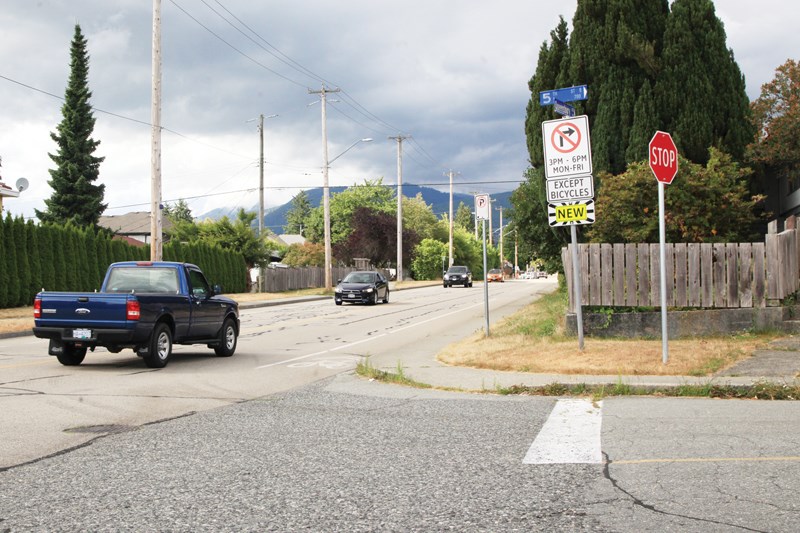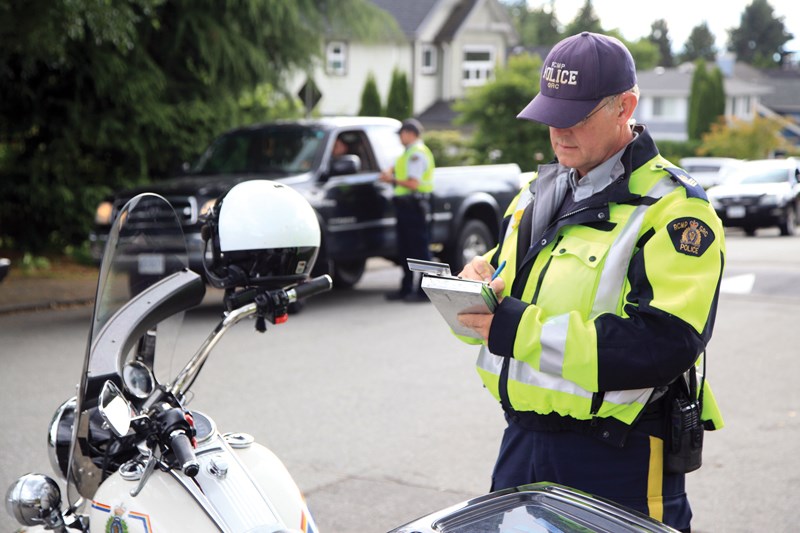Rat-runners beware. The trap has been set.
North Vancouver RCMP officers have been handing out hundreds of tickets to drivers violating traffic-calming measures in the Cloverley neighbourhood in a bid to avoid congestion emanating from the Ironworkers Memorial Second Narrows bridgehead.
“An immense amount of rat-running was going on,” said City of North Vancouver deputy engineer Peter Navratil, referring to the drivers who would cut through Heywood, Shavington or Cloverley Streets, or their lanes, when Keith Road or Third Street back up every afternoon. “The reliability on the Second Narrows has just gone nuts in the last six months. You’re seeing this on a daily basis and it’s driving (Cloverley residents) crazy.”
In the last two months, the city has made the 700 block of East Fourth Street one-way westbound and made right turns onto Fifth Street from Queensbury illegal from 3 to 6 p.m. And RCMP members have been out writing $121-tickets for folks disobeying the new traffic signs.
“After a couple weeks of grace period, it was not uncommon to hand out 100 tickets a day. As fast as they could write them, people were being ticketed,” said Cpl. Richard De Jong, North Vancouver RCMP spokesman. “That included those who actually live there as well.”
The traffic officers on scene have largely had community support, De Jong added.
“People were literally bringing them cookies and Kool-Aid and whatnot to show their support because they’ve seen a marked decrease in speed,” he said. “That shows it’s being effective.”
But, like squeezing a balloon, the enforcement has diverted the volume elsewhere through the neighbourhood and complaints are now coming in from the people on Sixth and Seventh streets. Navratil said.

Once regular traffic patterns return in the fall, the city will do traffic volume counts to measure the exact effects of the changes.
What’s likely to happen, Navrartil said, is adding one-way blocks, similar to the one on Fourth, to Fifth, Sixth and Seventh streets eventually.
Not everyone will welcome those restrictions but it should go a long way to keeping bridge traffic on Keith Road and Third, he said.
“The key fact is you’re never going to get consensus. You’re never even going to get around 50 per cent on this thing,” he said.
Previously, the city put up signs making right turns from the lane between Heywood and Shavington onto Keith illegal.
Those were mostly ignored until the street’s residents got together and, very politely, started informing drivers about the rule change, which has worked, said Kelly Willett, a resident on Shavington.
“I’ve been here 28 years. I’ve never seen it this quiet. It’s perfect. It’s working very well,” he said.
“It used to be incredibly dangerous on the lane. Incredibly dangerous. You can’t believe the disregard people have. It’s a very narrow lane and almost every house has kids. It’s scary.”
But he has noticed the same problem the city has. When you cut off one route, drivers will seek out the next closest shortcut.
Now Shavington has become the “speedway” but that has been the lesser of two evils as there is less risk to pedestrians and dog walkers there, Willett noted.
“I think engineering is doing a great job tackling this road by road by road and seeing where the traffic goes and what the best way to remedy it is. It’s absolutely impossible to keep everybody happy. There’s just a bucketload of traffic and it’s just going to get worse and worse and worse. It’s just how it’s managed.”
To those tempted to deke through the quiet, residential area in an effort to get home sooner, Willett asks them to consider what’s like for the people who live there.
“Would you want cars going 50, 60, 70 clicks on your lane?” he said. “Nobody wants that.”
The hope is that work redesigning the Highway 1 interchanges at the bridgehead will make traffic flow more efficiently, Navratil said, but traffic calming measures are ultimately only a workaround to solving the larger problem – getting people to choose alternate modes of transportation.



